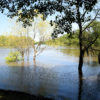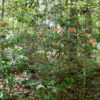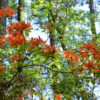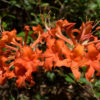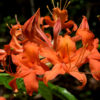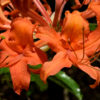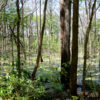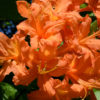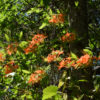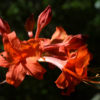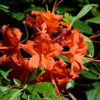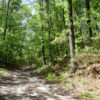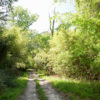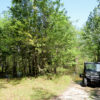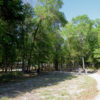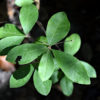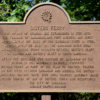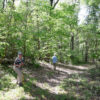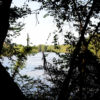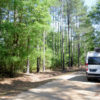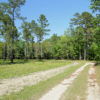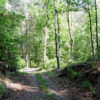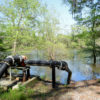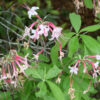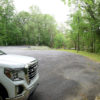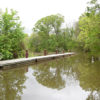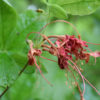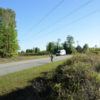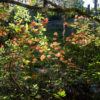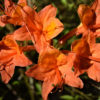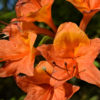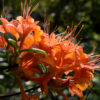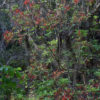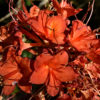The Savannah River forms the border between Georgia and South Carolina. We, John and Sally Perkins and I, took a route of about 38km (23.6M) along the lower Savannah River on the Georgia side to find as many locations of R. flammeum as possible. Here the slopes to the river were mostly steep and therefore promising. As so often, the main difficulty was getting to the river at all through fields, woods, and abundant private property. Out of 9 visited sites we could find R. flammeum at four of them. We started our search in the south, about 25km (15.5M) north of the city of Savannah at Ebenezer Landing (Effingham Co.) and worked our way up to Blue Springs (Screven Co.). We had no success at: Ebenezer Landing, Haddon Lake / Frying Pan Landing, the actual historic site of Sisters Ferry a short distance north of Cuba Road, Sisters Ferry Road East / Kennedy Lake and Dyals Landing Road. At the latter we didn’t even get to the river because of a gate. At the other places we could not find R. flammeum despite intensive search on the slopes towards the river. However, we had success at: Ebenezer Creek, Sisters Ferry of the topographic maps (Cuba Road), Tuckasee King Landing and Blue Springs. All rhododendrons shown here are R. flammeum unless otherwise stated, so I do not include captions for them.
We reached Ebenezer Creek via the cutting of a power line. Here we found a surprising number of plants in bloom, both along the road and hidden in the woods, but all quite far from the Creek and on barely sloping ground.
On the topographic maps, Cuba Road ends at a place there called Sisters Ferry Landing. The way to the creek was blocked by the gate of a farm. We approached a field worker who was working nearby. He was kind enough to go to his boss, Marvin Metzger, whose family came from Austria, so that we could explain our request to him. Marvin immediately appeared in person and was very friendly. Yes, he knew these orange flowering plants. They would grow directly behind his house in the steep slope to the river and would bloom just now. Unfortunately, he could not guide us there, because he had promised to a good friend that he could hunt turkeys there tomorrow with a few buddies. If we crept around there now, we would scare the animals away. Stuff happens …. But Marvin proved to be really obliging when he saw our disappointed faces. He drove with us on bumpy roads and also more or less cross-country through the forest a good 1km (0.6M) from the escarpment and there he showed us a R. flammeum. Unfortunately it was completely without flowers and had probably suffered somewhat because of overgrowth and fallen trees and was only very small. He then took us to the actual historic site on the Savannah River from which Sisters Ferry once operated. This was about 700m upstream from Marvin’s house at a point where there is a small indentation in the bluff through which one could get down to the river comfortably and not quite so steeply. There is also an old sign here about the historical significance of this place, but no tourist can legally read it because it is far on private property. Despite a thorough search, we could not find any R. flammeum here. However, a few days later Marvin sent me photos of some plants from behind his house and collected seeds from them during winter. They have germinated in the meantime. Besides, we already have an appointment for April 2023!
On the drive to Tuckasee King Landing, also known as Clyo Landing, we saw a few R. canescens on the side of the road about 2-3km before our destination. We searched the forest on the hillside at the landing site for quite a while to no avail. By the end, everyone had given up trying to work their way through the undergrowth matted with brambles, smilax, and Vitis rotundifolia. Only I was left, more slipping and crawling along the steep slope than walking the distance. To make things worse, there were again and again fallen tree trunks lying crisscross on the forst floor, which made it impossible to move forward at some point. So I finally turned around and worked my way back along the track I had made myself. How amazed was I when I found out that on my wild trail I must have already passed a tall R. flammeum. I had even unintentionally broken off a few branches while climbing! The plant must have bloomed profusely perhaps a week or two before, but was now completely faded. But it was to get even better. When I finally made the last steps out of the forest to the parking lot again, I had the good idea to get rid of some excess water here at the edge of the forest at the place where we had already entered this green hell. So I stood with my legs wide apart and let nature take its course, but immediately let out a loud scream because I had hit a plant just like the one we had been looking for all the time! This time everyone had walked past it. To our credit, it wasn’t very big and completely devoid of flowers.
At a nameless creek near Blue Springs we found beside a few small ones also two very large R. flammeum, one of which was still in full bloom and the other had already mostly finished blooming.

